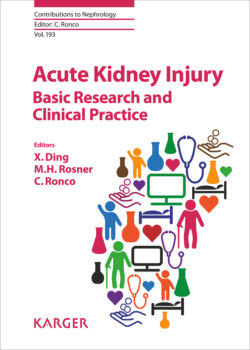Читать книгу Acute Kidney Injury - Basic Research and Clinical Practice - Группа авторов - Страница 13
На сайте Литреса книга снята с продажи.
Serum Creatinine Criteria for AKI Diagnosis
ОглавлениеSCr, a metabolite of creatine (synthesized from glycine and arginine in liver, pancreas and kidneys) is excreted unchanged into urine. SCr is one of the most commonly measured analytes in clinical practice worldwide, since the cost-benefit ratio is undoubtedly favorable. Nonetheless, although SCr remains a landmark biomarker in the diagnosis and classification of AKI, the relationship between SCr and GFR should be taken into consideration in order to keep in mind some limitations for AKI diagnosis:
• SCr levels tend to remain within normal values until approximately 50% of nephrons are lost or when the GFR fall to 60 mL/min/1.73 m2 [8]. For example, kidney donors maintain, after nephrectomy, normal SCr levels (and eGFR) despite having lost an entire kidney. On the contrary, an increase in SCr occurs only after the residual nephrons (commonly <50%) encounter a further loss of kidney function. Therefore, SCr is not an accurate marker of renal function when the GFR is >60 mL/min/1.73 m2 [8].
• Up to 15% of creatinine is actively secreted by the tubules leading to a creatinine clearance (CrCl) and GFR overestimation [9]. This overestimation is quite unpredictable and might vary in the same patient with declining GFR.
• Some drugs inhibit the tubular secretion of creatinine (e.g., trimethoprim and cimetidine) leading to an increase in SCr values when GFR remains constant [10–12]. On the other hand, the production of creatinine, from muscular creatine, could be influenced negatively in severe hepatic disease and positively in rhabdomyolysis [12, 13].
• Another important limitation, especially in critically ill patients and elderly patients with cancer, is that SCr may vary with decrease in muscle mass (i.e., sarcopenia), because creatinine is a product of muscle catabolism [12]. Moreover, decreased production of creatinine has been shown in sepsis [14] and may also result in false negatives. This association with muscle mass explains why similar SCr concentrations may correspond to different values of GFR in subjects with different physical characteristics (e.g., weight, pediatric or geriatric age, gender, or ethnicity).
• SCr can be influenced by diet: food rich in proteins (e.g., red meat) can increase the SCr, and GFR also increases with such food intakes in patients with preserved renal functional reserve (RFR) [15].
• Fluid loading or overload may dilute SCr resulting in a delayed or even missed diagnosis of AKI [16].
• Finally, the KDIGO creatinine criteria require a baseline creatinine value, since the diagnosis is based on changes in concentration compared with a baseline referred to the premorbid level. Since a baseline value may not be available, several surrogates have been proposed [6]. Calculation with an eGFR equation that considers a normal eGFR (75 mL/min/m2) does not take into account the possibility of undiagnosed chronic kidney disease resulting in false positives. Moreover, using hospital or ICU admission SCr does not take into account the possibility of community-acquired AKI [17].
